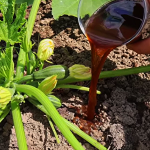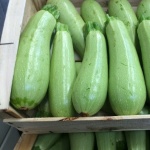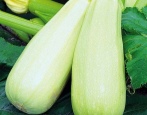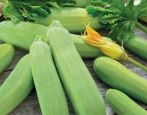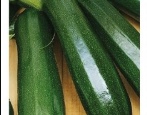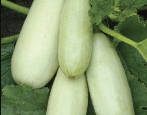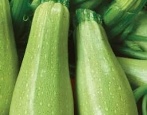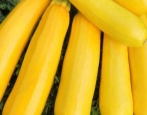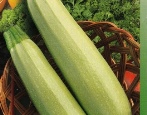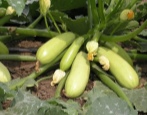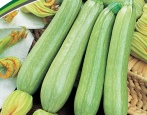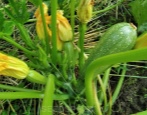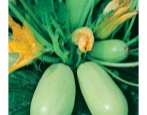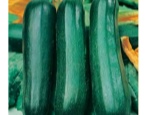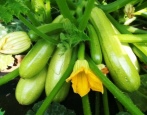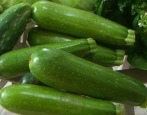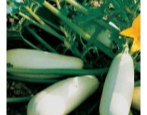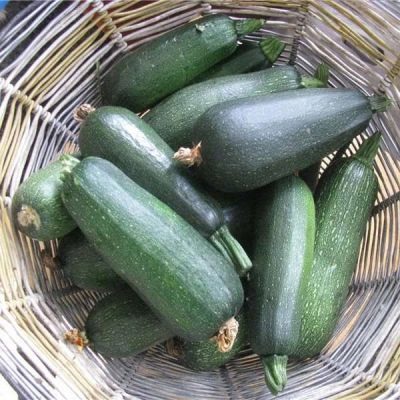
- Authors: Tarakanov G.I., Maksimov S.V., Tarakanov I.G., Klimenko N.N., Andrievskaya S.A.
- Year of approval: 2009
- Ripening terms: early maturing
- The period from germination to harvest: 40-45 days
- Description of the plant: compact
- Leaves: medium, green, medium dissected
- Fruit shape: cylindrical
- Fruit color: dark green, speckled
- Color of the pulp: white or light yellow
- Pulp (consistency): thick, juicy, tender
Zucchini of the Skvorushka variety appeared in 2009. Its authors are breeders G. I. Tarakanov, S. V. Maksimov, I. G. Tarakanov, N. N. Klimenko and S. A. Andrievskaya. Despite the fact that the variety is relatively young, it has already managed to conquer the hearts of many gardeners with abundant yield, excellent taste and resistance to adverse climatic conditions.
Description of the variety
Zucchini Skvorushka belongs to the zucchini type. It is intended both for cultivation in greenhouses and for cultivation in the open field. The fruits are characterized by good transportability. Skvorushka is a highly productive, drought and cold tolerant variety. Recommended for growing in the Central and Volgo-Vyatka regions.
Characteristics of the appearance of plants and fruits
For this variety, a compact bushy form of growth is typical. Stems are thick and fleshy, light green in color, with soft pubescence. Leaves are medium-sized, green in color, moderately dissected in shape, covered with thin, non-rigid villi. The flowers are mainly of the female type, with a bright yellow hue.
Fruits are medium in size and in diameter, cylindrical in shape. The mass of one zucchini reaches 0.9-1.2 kg. The fruits are characterized by a dark green color with a pattern in the form of specks. The peel of the Skvorushka variety is very thin, with a slightly ribbed surface. Seeds are medium in size, cream in color, elliptical in shape.
Purpose and taste
The flesh of squash squash is thick, tender and juicy by its consistency. It is characterized by a white or slightly yellowish color. This variety is famous for its excellent taste. The dry matter content is 5.0-5.8%, the total sugar content is 3.1-4.0%.
The Skvorushka variety is ideal for fresh consumption, most often young fruits are added to salads. These zucchini are widely used in home cooking: they are boiled, stewed, fried. Fruits of the Skvorushka variety are universal for all types of processing, as well as for canning. In addition, they are characterized by good keeping quality: zucchini can be stored for up to 4 months without losing taste and presentation.
Ripening terms
Zucchini Skvorushka belongs to the early maturing varieties. The period from germination to harvest is 40-45 days. As a rule, fruit ripening lasts from July to September.
Yield
Skvorushka is a high-yielding variety of zucchini. Average yields are 580-735 c / ha. The fruits ripen together, which is very important when harvesting on an industrial scale.
Growing and care
Zucchini Skvorushka is a relatively unpretentious variety with good immunity, but its cultivation has its own characteristics. With the seedling method, seed is planted in April, and in May or June, the plants are moved to a permanent place of growth. When planting directly in open ground, the seeds are best sown in late May - early June to a depth of 3-5 cm.A planting scheme of 70x70 cm should be strictly observed.The site should be as protected from the winds as possible and be well warmed up by the sun, since this variety is thermophilic.
The Skvorushka variety requires regular abundant watering for high yields. You should also often loosen the soil near the plants and conduct weed control in a timely manner.
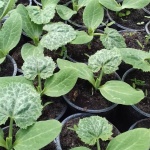
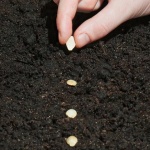
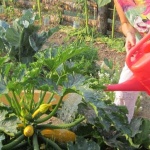
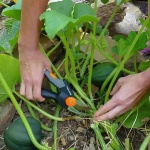
Soil requirements
Sandy and loamy soils with good aeration are ideal for growing this variety of zucchini. They should be rich in humus and not have stagnant groundwater or rainwater. Experienced gardeners recommend planting zucchini in the place where tomatoes, potatoes, eggplants or onions grew before them. Mineral dressing should be applied to the soil very carefully, since Skvorushka has a very sensitive root system. Top dressing should always be diluted with water so as not to burn the plant roots.
